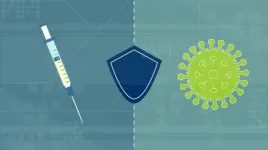(Press-News.org) The first personalised advice on the most effective exercise to lower blood pressure is published today in the European Journal of Preventive Cardiology, a journal of the European Society of Cardiology (ESC).1 The ESC consensus document recommends specific activities according to an individual's current blood pressure level.
One in four heart attacks are caused by high blood pressure. It is estimated that by 2025, around 60% of the world's population will have hypertension. While it is widely accepted that exercise lowers blood pressure, until now recommendations have focused on the amount of exercise per week, without considering an individual's starting blood pressure level.
This consensus document, for the first time, used an analysis of the highest quality evidence to produce detailed guidance on how to lower blood pressure in people with hypertension, high-normal blood pressure, and normal blood pressure.
"The goal of the recommendations for all three groups is primarily to lower blood pressure," said first author Professor Henner Hanssen of the University of Basel, Switzerland. "Ultimately, through blood pressure reduction, we can reduce the risk of heart attack, stroke and death from cardiovascular disease - thereby spending more years of life in good health."
For each of the three groups, the paper outlines the first exercise priority for lowering blood pressure, followed by alternatives that still achieve reduction but to a lesser extent.
For people with hypertension (blood pressure of at least 140/90 mmHg), aerobic exercise is the most effective method. This includes activities such as walking, running, cycling or swimming. "In people with hypertension, the blood pressure reduction that can be achieved with aerobic exercise is the same, or even slightly more, than taking a single antihypertensive medication," said Professor Hanssen.
In those with high-normal blood pressure (130-139/85-89 mmHg), dynamic resistance training is the first priority. This refers to strength training typically involving at least six large muscle groups where muscle contraction results in movement - for example, lifting weights, squats, and push-ups.
People with normal blood pressure (less than 130/84 mmHg) benefit most from isometric resistance training. This involves static contraction of the muscles - for example, the handgrip exercise. "People with normal blood pressure, but who are at raised risk of developing hypertension, may be particularly motivated to keep their levels down," said Professor Hanssen.
He continued: "Obese individuals are very likely to develop high blood pressure if obesity persists over the years. Healthy individuals with a hypertensive parent are also at risk of developing high blood pressure, as are women who had high blood pressure during pregnancy (gestational hypertension). People in these groups can postpone or even prevent hypertension by exercising."
Professor Hanssen noted that physical activity should be done regularly to sustain the benefits. He said: "For most exercises, the blood pressure lowering effect lasts for about 24 hours, similar to medication, so it's best to be active every day if possible."
INFORMATION:
Authors: ESC Press Office
Tel: +33 (0)4 89 87 20 85
Mobile: +33 (0)7 8531 2036
Email: press@escardio.org
Follow us on Twitter @ESCardioNews
Funding: None.
Disclosures: A.C. received honoraria for lectures in symposia and educational activities sponsored by unrestricted grants from Abbott, Berlin-Chemie, Biolab, Boehringer-Ingelheim, Ferrer, Menarini, Merck and Sanofi-Aventis. M.S. reports personal fees from Novartis and Sanofi-Aventis. L.P. is lead author of the American College of Sports Medicine recent Pronouncement. All other authors have nothing to disclose.
Notes
References
1Hanssen H, Boardman H, Deiseroth A, et al. Personalized exercise prescription in the prevention and treatment of arterial hypertension: a Consensus Document from the European Association of Preventive Cardiology (EAPC) and the ESC Council on Hypertension.
Eur J Prev Cardiol. 2021. doi:10.1093/eurjpc/zwaa141.
Link will go live on publication:
https://academic.oup.com/eurjpc/article-lookup/doi/10.1093/eurjpc/zwaa141
About the European Society of Cardiology
The European Society of Cardiology brings together health care professionals from more than 150 countries, working to advance cardiovascular medicine and help people lead longer, healthier lives.
About the European Journal of Preventive Cardiology
The European Journal of Preventive Cardiology is the world's leading preventive cardiology journal, playing a pivotal role in reducing the global burden of cardiovascular disease.
New research led by the University of Bristol has revealed that crocodiles once flourished on land and in the oceans as a result of fast evolution.
Modern crocodiles are predators living in rivers, lakes and wetlands, grabbing fish, reptiles, birds and mammals with their conspicuous snouts and powerful jaws.
However, new research published today in the journal Proceedings of the Royal Society B, shows that ancient crocodiles were once much more varied because of rapid evolution.
In the time of the dinosaurs, some crocodiles experimented with dolphin-like adaptations to living in the oceans, and others lived on land as fast-moving plant-eaters.
The researchers studied over 200 skulls and jaws, including ...
SINGAPORE, 23 March 2021 - Scientists from Duke-NUS Medical School, the National Centre for Infectious Diseases (NCID) and the Agency for Science, Technology and Research (A*STAR) Infectious Diseases Labs found that antibodies against SARS-CoV-2 wane at different rates, lasting for mere days in some individuals, while remaining present in others for decades. The study, published in The Lancet Microbe, shows that the severity of the infection could be a deciding factor in having longer-lasting antibodies. Individuals with low levels of neutralising ...
A University of Birmingham-led study of top-flight UK rugby players - carried out in collaboration with the Rugby Football Union (RFU), Premiership Rugby, and Marker Diagnostics - has identified a method of accurately diagnosing concussion using saliva, paving the way for the first non-invasive clinical test for concussion for use in sport and other settings.
Following the team's previous research, which identified that the concentration of specific molecules in saliva changes rapidly after a traumatic brain injury, the researchers embarked on a three-year study in elite rugby to establish if these 'biomarkers' could be used as a diagnostic test ...
Potentially paves way for non-invasive diagnostic test at all levels of participation
On a par with the assessment currently provided in professional sports
Could work alongside 'gold standard' head injury protocol used in elite sports
Distinct chemical 'signatures' for concussion have been identified in the spit of elite male rugby players, reveals research published online in the British Journal of Sports Medicine.
This potentially paves the way for a non-invasive and rapid diagnostic test for the condition that could be used pitch side and after the game at all levels of participation, suggest the researchers.
This is especially important because ...
Scientists at the U.S. Department of Energy's Ames Laboratory have observed novel helical magnetic ordering in the topological compound EuIn2As2 which supports exotic electrical conduction tunable by a magnetic field. The discovery has significant implications for basic research into functional topological properties and may one day find use in a number of advanced technology applications.
Topological materials burst onto the scene in the physical sciences about fifteen years ago, decades after their existence had been theorized. Called 'topological' because their bulk electronic bands are "knotted" together, the surfaces of topological insulators "untie the knot" and become metallic. Researchers ...
People who received a flu shot last flu season were significantly less likely to test positive for a COVID-19 infection when the pandemic hit, according to a new study. And those who did test positive for COVID-19 had fewer complications if they received their flu shot.
These new findings mean senior author Marion Hofmann Bowman, M.D., is continuing to recommend the flu shot to her patients even as the flu season may be winding down.
"It's particularly relevant for vaccine hesitance, and maybe taking the flu shot this year can ease some angst about the new COVID-19 vaccine," says Hofmann, an associate professor of internal medicine and a cardiologist at the Michigan ...
While COVID-19 cases may be on the decline, the virus is still prevalent nationwide, and higher education institutions need to prepare for a successful 2021 academic year. New research from Clemson University in The Lancet Child & Adolescent Health, one of the world's premier peer-reviewed general medical journals, indicates how surveillance-based informative testing (SBIT) mitigates the spread of COVID-19 on campus, paving the way for other institutions, even those without the infrastructure or funding for mass-scale testing.
SBIT was implemented during the first two weeks of the Fall semester at Clemson. According to the study, ...
Another step towards understanding Alzheimer's disease has been taken at the Maisonneuve-Rosemont Hospital Research Centre. Molecular biologist Gilbert Bernier, and professor of neurosciences at Université de Montréal, has discovered a new function for the BMI1 gene, which is known to inhibit brain aging. The results of his work have just been published in Nature Communications.
In his laboratory, Bernier was able to establish that BMI1 was required to prevent the DNA of neurons from disorganizing in a particular way called G4 structures. This phenomenon occurs in the brains of people with Alzheimer's disease, but not in healthy elderly ...
Scientists have found new, unexpected behaviors when SARS-CoV-2 - the virus that causes COVID-19 - encounters drugs known as inhibitors, which bind to certain components of the virus and block its ability to reproduce.
Published in the Journal of Medicinal Chemistry, the research provides key insights for advancing drug design and drug repurposing efforts to treat COVID-19.
Researchers at the Department of Energy's Oak Ridge National Laboratory used neutron scattering to investigate interactions between telaprevir, a drug used to treat hepatitis C viral infection, and the SARS-CoV-2 main protease, the enzyme responsible for enabling the virus to reproduce.
They ...
When the human immunodeficiency virus infects cells, it can either exploit the cells to start making more copies of itself or remain dormant--a phenomenon called latency. Keeping these reservoirs latent is a challenge. A new paper, published in the Proceedings of the National Academy of Sciences, has found a way to look for chemicals that can keep the virus suppressed into its dormant state.
"The current drug treatments block healthy cells from becoming infected by the virus," said Yiyang Lu, a PhD student in the Dar lab at the University of Illinois Urbana-Champaign. "The latent reservoir poses a bigger problem because it can start producing the virus at any time. Consequently, patients have to remain on antiretroviral therapy all their lives to prevent ...


